Manners, Customs, Clothing
 |
 |
 |
 |
 |
 |
 |
Abandoning the Saucer - Part II
The Saucer in France & England
Although saucers have been used for centuries, it was not until the 17th and 18th centuries that the saucer acquired its distinctive role. Today, saucers serve as the indispensable companions of coffee cups and tea cups. In former times, however, they were used in the more literal etymological sense, since saucer dishes were used to serve sauces – the word
sauce gave saucer – (from Anglo-Latin saucerium and Old French saussier = sauce dish). I imagine there has been some similar flat bowl used for serving condiments since Antiquity.
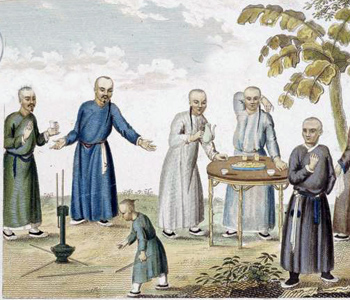 The invention of the saucer for the teacup was in the 17th century in China. An article explains its origin: “The idea of the saucer developed in the 17th century when the daughter of a Chinese military official found it difficult to handle the hot bowls of tea … and asked a local potter to devise a little plate on which to place the bowl.”
The invention of the saucer for the teacup was in the 17th century in China. An article explains its origin: “The idea of the saucer developed in the 17th century when the daughter of a Chinese military official found it difficult to handle the hot bowls of tea … and asked a local potter to devise a little plate on which to place the bowl.”
It was to prevent the discomfort and potential dangers of handling hot bowls (for handles were not added to the “cups” until some time later) that the saucers were introduced as a companion to the teacup. A simple and ingenious idea!
A ‘coincidence’ of history
Quite significantly, the Chinese were adding saucers to their tea sets at the very moment in history that tea was being introduced to Europe. Thus, early on Europeans adopted the use of the saucer from the Chinese. Then, naturally, as is the vocation of Europeans, particularly the French, the tea customs adopted from China were refined and adapted to suite the Western peoples of Christendom.
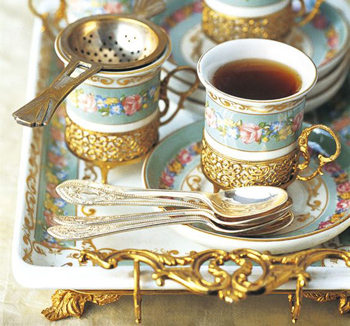 The Chinese invented the saucer for a utilitarian purpose – to avoid the problem of hot bowls. One could imagine that the first saucer, made by the potter in China, was rather primitive. Only later would crude coasters become those finely-motifed saucers we know today, whether we unfortunately keep them in cabinets perennially unused and kept only to be displayed for amusement, or whether we have the civilized pleasure of using them for betimes tea and coffee and other confections with fine china and silverware…
The Chinese invented the saucer for a utilitarian purpose – to avoid the problem of hot bowls. One could imagine that the first saucer, made by the potter in China, was rather primitive. Only later would crude coasters become those finely-motifed saucers we know today, whether we unfortunately keep them in cabinets perennially unused and kept only to be displayed for amusement, or whether we have the civilized pleasure of using them for betimes tea and coffee and other confections with fine china and silverware…
However, a question comes to mind: How could such a custom, which we have already said is so very simple, be invented in China rather than civilized Europe? Let me propose an explanation.
I think if Christendom would have been faithful, the saucer custom would have been invented in Catholic Europe. But due to the great apostasy represented by the Renaissance, perhaps God sent this civilized inspiration to a still pagan people
This theory can be supported by the fact that by the 17th century, the Chinese had been using teacups sans saucer for centuries, albeit in a more primitive form. What a “coincidence” that saucers were invented after those many, many centuries simultaneously with the introduction of tea into Europe!
The saucer’s introduction into France & England
France and England are the two nations which are chiefly to be credited for spreading the cup-and-saucer in Christendom. As far as I could verify, the French received the saucer first; from France the tea saucer was passed to the English.
In France, the custom was rapidly assimilated and refined, the normal process of the French. Dealing with another topic, Dr. Plinio said that the French have a special capacity – a kind of vocation – to refine every aspect of life. As firstborn daughter of the Church that became a leader of the nations of Christendom, normally other peoples would follow France’s example. When the French promoted the use of the saucer, the other nations began to emulate.
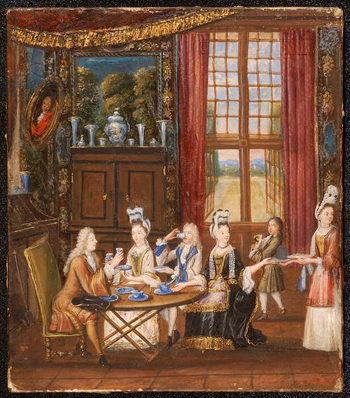 I think the painting at left picturing a French family scene – appropriately entitled in English The Tea Party – does much justice in expressing this peculiar vocation of the French people. Note that the family in the painting is using saucers with their tea and they sit at the table with a natural elegance. They are very much “at home” and connatural with that ambience. Strikingly, their dignified tea cups and saucers are equally connatural with the ambience.
I think the painting at left picturing a French family scene – appropriately entitled in English The Tea Party – does much justice in expressing this peculiar vocation of the French people. Note that the family in the painting is using saucers with their tea and they sit at the table with a natural elegance. They are very much “at home” and connatural with that ambience. Strikingly, their dignified tea cups and saucers are equally connatural with the ambience.
It is also rather remarkable that the painting at left was made in the late 17th century (not more than a few decades after tea was first introduced to Europe), which proves in very deed how rapidly the French assimilated tea and its associated customs, and how quickly they refined it.
But it is to the English that those niceties such as fine china, the tea rooms and gardens, and their tea times are to be credited. To this day the English have maintained the refined custom of the consumption of tea and the manufacture of fine china. However, even in England corruption has set in with the lamentable spread of plastic “mugs” and “Keurig”-style tea in paper cups…
Yet, by virtue of its former Empire, the English people are to be particularly credited for spreading civilized customs like the saucer to the four corners of the earth.
Saucers as an example of Organic Society
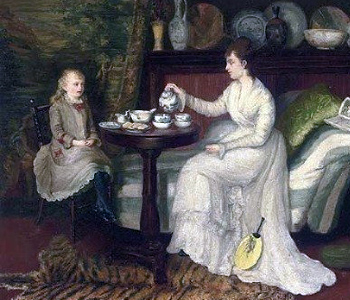 The saucer’s introduction to tea drinking and its rapid adoption among all the
social classes, thereby elevating all levels of society, is an excellent concrete example of Organic Society.
The saucer’s introduction to tea drinking and its rapid adoption among all the
social classes, thereby elevating all levels of society, is an excellent concrete example of Organic Society.
In the beginning, the nobles adopted the custom, as proved by the paintings of the times. This spread to the bourgeoisie and then to the lower classes, who respectively admired the refined tea times and imitated in their own way. Soon everyone was using saucers with their tea and coffee.
Would that all civilized men, great and small, would have saucers in their cupboard! For me this a very charming thought, all the more so because today things have changed so radically for the worse. Yes, in comparison to today’s neo-barbarians, the simplest people of old were like kings and queens…
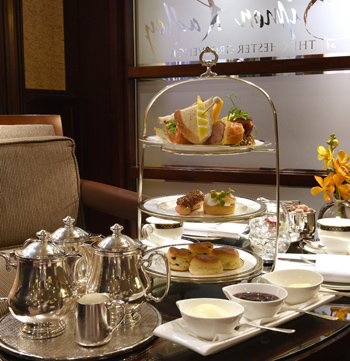 To be continued
To be continued

Posted March 2, 2020

The Chinese were saucer-less until the 17th century
It was to prevent the discomfort and potential dangers of handling hot bowls (for handles were not added to the “cups” until some time later) that the saucers were introduced as a companion to the teacup. A simple and ingenious idea!
A ‘coincidence’ of history
Quite significantly, the Chinese were adding saucers to their tea sets at the very moment in history that tea was being introduced to Europe. Thus, early on Europeans adopted the use of the saucer from the Chinese. Then, naturally, as is the vocation of Europeans, particularly the French, the tea customs adopted from China were refined and adapted to suite the Western peoples of Christendom.

The French savoir faire turned the tea service into a work of art
However, a question comes to mind: How could such a custom, which we have already said is so very simple, be invented in China rather than civilized Europe? Let me propose an explanation.
I think if Christendom would have been faithful, the saucer custom would have been invented in Catholic Europe. But due to the great apostasy represented by the Renaissance, perhaps God sent this civilized inspiration to a still pagan people
This theory can be supported by the fact that by the 17th century, the Chinese had been using teacups sans saucer for centuries, albeit in a more primitive form. What a “coincidence” that saucers were invented after those many, many centuries simultaneously with the introduction of tea into Europe!
The saucer’s introduction into France & England
France and England are the two nations which are chiefly to be credited for spreading the cup-and-saucer in Christendom. As far as I could verify, the French received the saucer first; from France the tea saucer was passed to the English.
In France, the custom was rapidly assimilated and refined, the normal process of the French. Dealing with another topic, Dr. Plinio said that the French have a special capacity – a kind of vocation – to refine every aspect of life. As firstborn daughter of the Church that became a leader of the nations of Christendom, normally other peoples would follow France’s example. When the French promoted the use of the saucer, the other nations began to emulate.

A French family having its "tea party" time
It is also rather remarkable that the painting at left was made in the late 17th century (not more than a few decades after tea was first introduced to Europe), which proves in very deed how rapidly the French assimilated tea and its associated customs, and how quickly they refined it.
But it is to the English that those niceties such as fine china, the tea rooms and gardens, and their tea times are to be credited. To this day the English have maintained the refined custom of the consumption of tea and the manufacture of fine china. However, even in England corruption has set in with the lamentable spread of plastic “mugs” and “Keurig”-style tea in paper cups…
Yet, by virtue of its former Empire, the English people are to be particularly credited for spreading civilized customs like the saucer to the four corners of the earth.
Saucers as an example of Organic Society

Every class adopted the elegant tea service
In the beginning, the nobles adopted the custom, as proved by the paintings of the times. This spread to the bourgeoisie and then to the lower classes, who respectively admired the refined tea times and imitated in their own way. Soon everyone was using saucers with their tea and coffee.
Would that all civilized men, great and small, would have saucers in their cupboard! For me this a very charming thought, all the more so because today things have changed so radically for the worse. Yes, in comparison to today’s neo-barbarians, the simplest people of old were like kings and queens…

Gentlemen's tea at the
Chester Grosvenor Hotel, United Kingdom

Posted March 2, 2020
______________________
______________________








